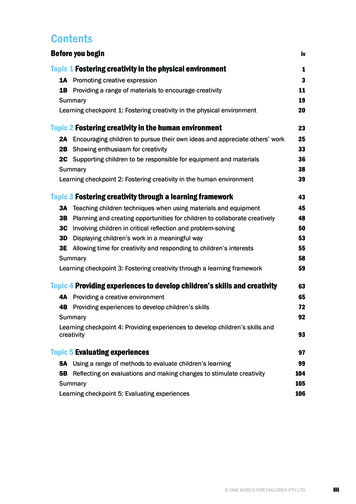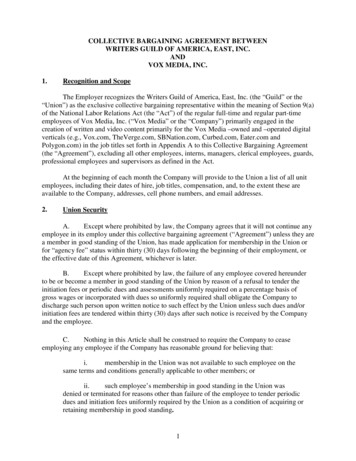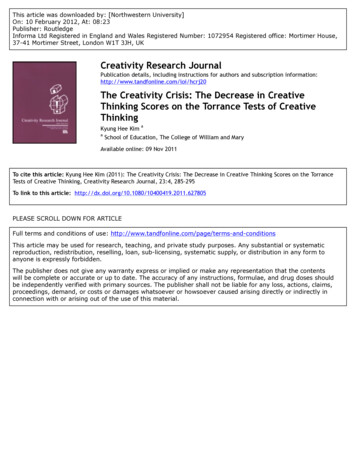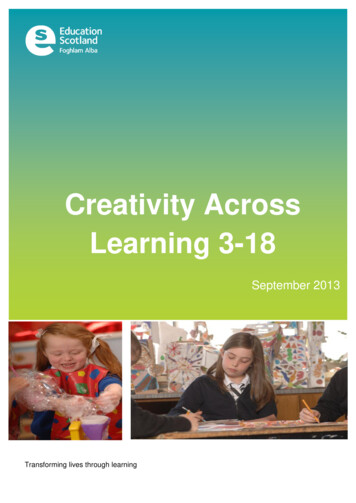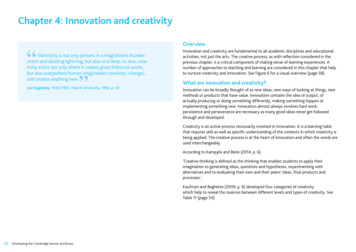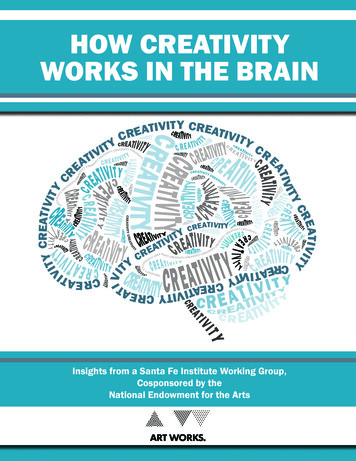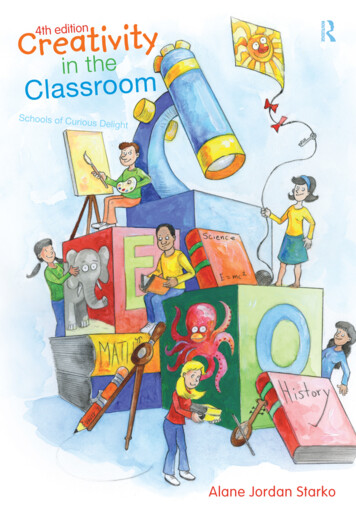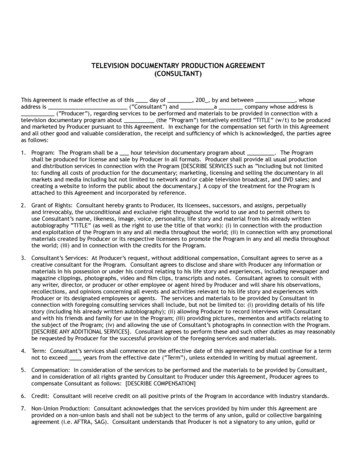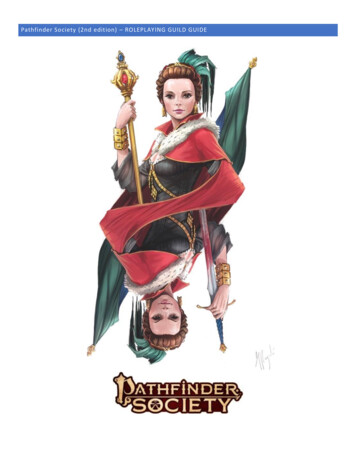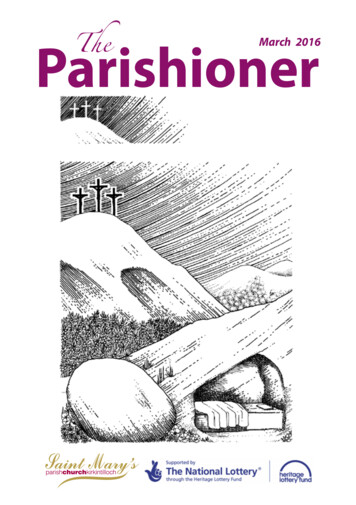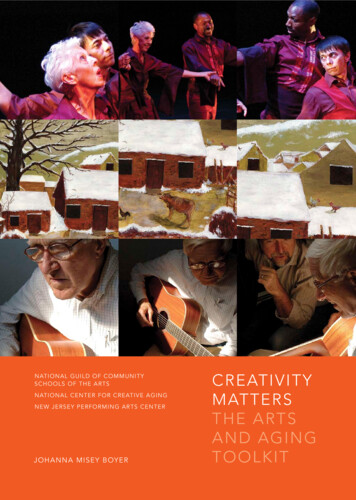
Transcription
Nat ional G ui l d o f Comm uni tyS chool s of t he Ar tsNat ional Cen t er for Creat iv e A gingNew J ersey Per f orming Ar t s Cent erJ OHANNA MISEY BOYERCREATIVITYMATTERSTHE AR TSAND AGINGTOOLKIT
CREATIVITYMATTERSTHE AR TSAND AGINGTOOLKIT
Creativity Matters: The Arts and Aging Toolkit 2007 by the National Guild of Community Schoolsof the Arts, 520 8th Avenue, Suite 302, New York, NY 10018All rights reserved. Published 2007Printed in the United States of AmericaEvaluation: Performance Results, Inc., Laytonsville, MarylandEditing: Ellen Hirzy, Washington, DCDesign: fuszion, Alexandria, VirginiaPhoto Credits: Cover (top) and 14: PARADIGM, SolomonsCompany/Dance, Inc., New York, NY; cover (center): detailof work by Hang Fong Zhang, Center for Elders and Youthin the Arts, Institute on Aging, San Francisco, CA, Jeff Chapline,artistic director; cover (bottom) and 184: Concord CommunityMusic School, Concord, NH, National Guild member since1984; xxii, 32, 174, 178: Stagebridge Senior Theatre Company,Oakland, CA; 44: Amatullah Saleem (storyteller), Pearls ofWisdom program, Elders Share the Arts, Brooklyn, NY; 24:Alzheimer’s Association Orange County, Irvine, CA; 70: detailof work by Celia Sacks, Center for Elders and Youth in the Arts,Institute on Aging, San Francisco, CA, Jeff Chapline, artisticdirector; 122: The Golden Tones, Wayland, MA; 146: Irv Williamsand Carla Vogel (musician and dancer), Kairos Dance Theatre,Minneapolis, MN; 164: Jesse Neuman-Peterson and MosesWilliams (dancers), Kairos Dance Theatre, Minneapolis, MN.The author would like to acknowledge the support of NeilA. Boyer and the inspiration of the ladies on the gardenlevel and her own well elder, Edward G. Misey. In memoryof Rachel L. Misey.To order, contact:National Guild of Community Schools of the ArtsPhone: 212–268–3337E-mail: guildinfo@nationalguild.orgWeb: www.nationalguild.org.iiCREATIVITY MATTERS THE ARTS AND AGING TOOLKIT
CREATIVITYMATTERSTHE AR TSAND AGINGTOOLKITJ O H A N NA MISEY BOYER
SponsorsThe National Guild of Community Schools of the Arts, National Centerfor Creative Aging, and New Jersey Performing Arts Center would liketo thank the following funders for their visionary support:ivCREATIVITY MATTERS THE ARTS AND AGING TOOLKIT
The National Guild of Community Schools of the Arts, the National Center for Creative Aging,and the New Jersey Performing Arts Center value lifelong learning in the arts. We believe thatindividuals and communities reap profound benefits from participating in arts programs,especially when those programs are led by professional teaching artists. In recognitionof these shared beliefs, we joined forces in 2006 to explore how best to serve our respectivemembers and audiences, particularly the growing population of older adults.Thanks to the generous and enthusiastic support of our funders—MetLife Foundation,NAMM: The International Music Products Association, the Healthcare Foundation of NewJersey, and Roche—we are pleased to bring you Creativity Matters: The Arts and Aging Toolkit.Designed for both the arts and aging services fields, this resource offers detailed advice on,and examples for, designing, implementing, and evaluating professionally conducted community arts programs for older adults. The toolkit also is online at www.artsandaging.org.We look forward to releasing a Spanish-language edition and Web site in 2008.As leaders of organizations that support the intersection of arts, education, and community,it is our hope that this toolkit will inspire readers to start or continue their work in the artsand aging field and to trumpet the importance of the arts to older adults’ mental and physicalhealth. We should encourage and support the continued creativity of older adults who havemuch to contribute to the quality of life in our communities.Jonathan HermanExecutive DirectorNational Guild ofCommunity Schoolsof the ArtsSusan PerlsteinFounder and Directorof EducationNational Centerfor Creative AgingLawrence P. GoldmanPresident and CEONew Jersey PerformingArts Center
ContentsIntroductionxviiChapter 1 Understanding the Context for Arts and Aging ProgramsDescribing Normal AgingThe Language of AgingReality vs. Myth344Changes During AgingPhysical and Biological ChangesSocial and Emotional Changes446The Demographics of 7788Productive Aging8Implications for Arts and Aging Programs9Big-Picture Challenges to Arts and Aging ProgramsFear of AgingIsolation of Older AdultsCommunicating ValueChange910111212Key Points about the Context for Arts and Aging Programs13vi1CREATIVITY MATTERS THE ARTS AND AGING TOOLKIT
Chapter 2 How Arts Participation Benefits Older Adults15Enhancing Community Quality of LifeArts and Aging in Community Cultural Development1616Enhancing Individual Quality of LifeHow Cognitively Fit Older Adults BenefitHow Older Adults with Dementia Benefit202122Key Points about the Benefits of ArtsParticipation to Older Adults23Chapter 3 The Aging Services Field25Understanding Key IssuesIncreasing CostsEmphasis on Home- and Community-Based CareConsolidated Consumer InformationReducing Residential Facility Staff Turnoverand Increasing MoraleAddressing Family Caregiver BurnoutImplications for the Arts26262627Exploring 29Making Connections29Key Points about the Aging Services Field31272728vii
Chapter 4 The Arts Field33Understanding Key IssuesExpanded Definition of Arts EducationArts ParticipationA Broader Definition of the ArtsCommunity EngagementDemonstrated ImpactScarce ResourcesProfessional Development for Teaching ArtistsSpecial Issues for Creative Arts Therapies343434343434353535Exploring InfrastructureFederalRegionalStateLocalArts EducationCreative Arts TherapiesFoundations3636373737383838Making Connections39Key Points about the Arts Field41Chapter 5 Effective Practices45Defining Effective Practices46Identifying Outcome GoalsMasterySocial Engagement474748Influencing Others49Understanding Adult Learning50viiiCREATIVITY MATTERS THE ARTS AND AGING TOOLKIT
Program ExamplesThe Golden TonesNew Horizons MusicLuella Hannan Memorial FoundationKairos Dance TheatreElders Share the ArtsOsher Lifelong Learning Institute, University of Southern Maine52525457596264Key Points about Effective Practices68Chapter 6 Program DesignPlanning the ProgramConducting Internal and Eternal AssessmentInternal AssessmentEternal AssessmentCreating an Advisory CommitteeEstablishing PurposeDetermining Mission, Vision, and ValuesSetting Goals and ObjectivesDesigning ActivitiesApplying Andragogy and Instructional DesignEstablishing TrustSetting ChallengesEnsuring SuccessAccommodating DiversityEncouraging ParticipationSetting Session Length and FrequencyFacilitating a Learning CommunityEvaluationReminiscenceCommunity Sharing of ArtKey Points about Program PlanningFinding and Working with PartnersUnderstanding PartnershipsPlanning PartnershipsIdentifying and Securing PartnersTraining PartnersImplementing the PartnershipKey Points about 939495969697100102103104ix
Securing ResourcesExploring Revenue SourcesCreating a BudgetDeveloping a PlanMaking the CaseUnderstanding ChallengesKey Points about Resource Development105105108109112113114Marketing to ParticipantsGetting the Word OutMotivating ParticipantsUsing Your AssetsCreating MaterialsKey Points about Marketing to Participants115115117117118119Summary120Chapter 7 Program Implementation123Setting the StageEnsuring Physical and Programmatic AccessibilitySetting Group ExpectationsKey Points about Setting the Stage124124126127Keeping on TrackAssessing Progress and ProcessPlanning Community Sharing of the ArtKey Points about Keeping on Track128128129134Supporting Teaching ArtistsAssessing QualificationsMaking the HireConducting TrainingProviding SupportTrain the Trainer ProgramsKey Points about Supporting Teaching Artists135135137138140141144 CREATIVITY MATTERS THE ARTS AND AGING TOOLKIT
Chapter 8 Evaluation147Defining Terms148Understanding Benefits149Planning the EvaluationDetermining What You Want to LearnAssessing CostsIdentifying AudiencesCreating Communication ToolsSeeking Help150150153153154155Implementing the Evaluation156Evaluating People with Dementia162Key Points about Evaluation163Chapter 9 Public Awareness165Defining Terms166Identifying Audiences167Developing Messages167Selecting Messengers169Developing Methods169Key Points about Public Awareness172Chapter 10 Looking to the Future175xi
Notes179Glossary185Contact Information195Appendixes2011. Program Logic Model Example2022. Project Timeline Formula and Curriculum Planning Format2043. Fundraising Tools2054. Marketing Tools2165. Policies and Procedures Example2186. Teaching Artists Tools2207. Evaluation Tools225xiiCREATIVITY MATTERS THE ARTS AND AGING TOOLKIT
AcknowledgmentsProject PartnersKenneth Cole, Program Director, NationalGuild of Community Schools of the Arts,New York, NYDesiree Urquhart, Former Vice Presidentof Arts Education, New Jersey PerformingArts Center, Newark, NJSusan Perlstein, Founder and Directorof Education and Training, National Centerfor Creative Aging, Washington, DCDonna Bost-White, Director of ArtsEducation, New Jersey Performing ArtsCenter, Newark, NJGay P. Hanna, Executive Director, NationalCenter for Creative Aging, Washington, DCAdvisory CommitteeGene Cohen, M.D., Director, Centeron Aging, Health, and Humanities, GeorgeWashington University, Washington, DCRoy Ernst, Professor Emeritus, EastmanSchool of Music, and Founder, New HorizonsMusic, Rochester, NYBeverly Ferry, Executive Director, WabashCounty Council on Aging, Inc. (representingthe National Institute of Senior Centers),Wabash, INMaria Genné, Artistic Director, Kairos DanceTheatre, Minneapolis, MNJohn McEwen, Executive Director, NewJersey Theatre Alliance, Morristown, NJRobin Middleman, Arts EducationCoordinator, New Jersey State Councilon the Arts, Trenton, NJHarry R. “Rick” Moody, Director ofAcademic Affairs, AARP, Washington, DCPatricia A. Polansky, Assistant Commissioner,Division of Aging and Community Services,New Jersey Department of Health and SeniorServices, Trenton, NJLisa Shaw, Former Director of AdultPrograms, Levine School of Music,Washington, DCxiii
InterviewsUnless otherwise noted, all quotationsare from phone interviews conducted withleaders in the arts and aging field betweenNovember 2006 and January 2007 and inJuly and August 2007. The project partnerswould like to thank the following individualsfor their time and advice:Alzheimer’s Poetry ProjectGary Mex Glazner, DirectorSanta Fe, NMElder Craftsmen, Inc.Janet Langlois, Former Executive DirectorNew York, NYElders Share the ArtsCarolyn Zablotney, Executive DirectorBrooklyn, NYArts for the AgingJanine Tursini, Executive DirectorBethesda, MDEngAGE: The Art of Active Aging(formerly More Than Shelter For Seniors)Maureen Kellen-Taylor, Vice PresidentBurbank, CAArtAge PublicationsThe Senior Theatre Resource CenterBonnie Vorenberg, PresidentPortland, OREvergreens Senior HealthCare SystemJanie Johnson, Renaissance DirectorGreensboro, NCCenter for Elders and Youthin the Arts/Institute on AgingJeff Chapline, Administrativeand Artistic DirectorSan Francisco, CAThe Golden TonesMaddie Sifantus, Founder and DirectorWayland, MACreative Aging CincinnatiMary Kay Morris, Former Executive DirectorCincinnati, OHDonovan Scholars Program,University of KentuckyMichael D. Smith, Director, Council on Aging,School of Public HealthLexington, KYxivDrum Circle Facilitators GuildNelli Hill, SecretaryFounder, Playful Spirit AdventuresFulton, MDFoundation for Quality CareEd Graham, Former PresidentAlbany, NYThe Intergeneration Orchestra of OmahaChris Gillette, Co-FounderDirector, Community Services Division,Eastern Nebraska Office on AgingOmaha, NECREATIVITY MATTERS THE ARTS AND AGING TOOLKIT
Kairos Dance TheatreMaria Genné, Artistic DirectorMinneapolis, MNLevine School of MusicLisa Shaw, Former Directorof Adult ProgramsWashington, DCLiz Lerman Dance ExchangeJohn Borstel, Humanities DirectorTakoma Park, MDThe Luella Hannan Memorial FoundationPam Halladay, Senior Program OfficerDetroit, MIMemories in the MakingLa Doris “Sam” Heinly,National Program ConsultantNewport Beach, CANational Coalition of CreativeArts Therapies AssociationsLaura Greenstone, ChairSilver Spring, MDNational Institute of Senior CentersBeverly Ferry, DelegateExecutive Director, Wabash CountyCouncil on Aging, Inc.Wabash, INNational Center for Creative AgingSusan Perlstein, Founder,Director of Education and TrainingWashington, DCNational Endowment for the ArtsBarry Bergey, Director,Folk and Traditional ArtsWashington, DCNew Horizons MusicRoy Ernst, FounderCorning, NYNew Jersey Office of Area Agencyon Aging AdministrationTina Wolverton, DirectorTrenton, NJNew Jersey Departmentof Health and Senior ServicesPat Polansky, Assistant Commissioner,Division of Aging and Community ServicesTrenton, NJNew Jersey Intergenerational OrchestraSusan Peterson, Vice Presidentand Administrative DirectorCranford, NJThe OASIS InstituteMarcia Kerz, PresidentSt. Louis, MOOsher Lifelong Learning InstituteNational Resource CenterKali Lightfoot, DirectorPortland, MERoland Corporation U.S.Lynda SmithLos Angeles, CA
The Seasoned PerformersMartha Haarbauer, Executive DirectorBirmingham, ALSPIRAL Arts, Inc.Jean Badran, Director of Elder ArtsPriscilla Dreyman, Executive DirectorPortland, MEStagebridge Senior Theatre CompanyStuart Kandell, DirectorOakland, CATimeSlipsAnne Davis Basting, Founder and DirectorMilwaukee, WIYamaha Corporation of AmericaMike Bates, Director, Institutional andCommercial Services, MMGBuena Park, CA
IntroductionCreativity. According to the Random HouseUnabridged Dictionary, it is “the ability totranscend traditional ideas, rules, patterns,relationships, or the like, and to createmeaningful new ideas, forms, methods,interpretations, etc.” A more concise definition is “bringing something new of valueinto existence.” The etymology of “creativity,”however, is what resonates for those of uswho are passionate about embedding thearts — or creativity — in the lives of olderadults and the communities in which theylive. The word comes from the Latin creatus,which means “to have grown.” Older adultshave grown in knowledge and experience,and we should value them for what theycontribute to each of us individually andto our communities.The arts are the key. They enable us tocommunicate effectively within and betweengenerations, making sense of and reconcilinglife experiences, understanding and celebrating the present, and creating a legacy forthe future. They also allow us to experimentwithout fear of failing — to be challenged —and to succeed in learning new skills anddiscovering latent ones. Strengtheningconnections among older adults, family,friends, residents, and caregivers, the artscreate a sense of community in which eachperson’s contribution is respected. In sum,the arts enhance quality of life.No matter what their age or their physicalor mental ability, older adults can andshould participate in the arts. And not justany arts, but high-quality, participatoryarts programs conducted over a significantperiod by professional teaching artists.The National Guild of Community Schoolsof the Arts, the National Center for CreativeAging, and the New Jersey PerformingArts Center believe that the arts are of vitalimportance to the lives of current and futuregenerations of older adults. Many leadersin the arts, healthcare, and aging servicesindustries share this belief, but too few havecreated or sustained effective arts and agingprograms. Now is the time to be part of theprocess, part of the solution: the “beyondbingo” generation is here.This resource is designed for leaders andprogram staff in public, nonprofit, andfor-profit arts and humanities organizationsand institutions and in healthcare and agingservices organizations, corporations,and institutions. It is intended to increasethe expertise of those who direct existingcommunity arts and aging programs andto give others in the community the toolsto take the first step — and keep going.xvii
This information will also benefit:nnn Teaching artists who want to workwith older adults Leaders and staff of lifelong learningorganizations and programs (such ashigher education) who are interested inintentionally including the arts in theircurriculums Private- and public-sector funders whoneed to define effective practices beforecreating or revising guidelinesThe Arts and Aging Toolkit will help you:nnnnnnnn Appreciate why this is a pivotal timefor arts and aging in the United States Understand that older adults continueto learn and benefit from education Learn about the aging services field Learn about the arts fieldand community arts Discuss the benefits of professionallyconducted, participatory arts and agingprograms with a variety of stakeholders(elected officials, funders, partners,and policymakers) Design, implement, market, support,evaluate, and sustain these programsfor older adults Find and train teaching artists whoare directly responsible for deliveringprogramsEnhancing quality of life by embeddingthe arts in the lives of older adults and thecommunities in which they live is more thana goal. It is one facet of a broader movementin the arts and aging services fields: a pushtoward designing or redesigning communityso that the infrastructure works harmoniouslyto support everyone’s needs as defined by allcommunity members.How to Use This ToolkitIf you are reading this resource, chancesare you want to develop a new arts and agingprogram or enhance an existing one. Youmay be an experienced program designeror someone just starting out. You probablyidentify with or work in the arts or agingservices fields. You may be hoping foranswers — knowledge, rationales, tips,models, and resources — and this toolkit isintended to provide them. Your commitmentand passion for older adults and the arts willhelp you face the challenge and make thedifference between success and failure.Chapters 1 through 5 provide the background to help you design and implementan arts and aging program. These chaptersexplain the context for arts and aging today;the benefits of arts participation for olderadults; issues, infrastructure, and opportunities in the aging services and arts fields;and effective practices for arts and agingprograms. Locate advice, training, and assistanceChapters 6 through 9 offer practical,how-to guidance for program designand implementation; program evaluation;and public awareness. These chaptersillustrate important concepts with concretexviiiCREATIVITY MATTERS THE ARTS AND AGING TOOLKIT
examples from successful programs.You can learn something from all of them,whether they are focused on well or frailelders, people who live in the communityor in a residential facility, or older adultswith dementia.We have designed this toolkit for a varietyof experience and interest levels. Manyreaders will find something of interestin every chapter, and others will browsethe sections that are most relevant tothem. Here is a roadmap to make thetoolkit work for you:If you are Read Just starting out or interested in this subjectThe entire toolkitAn older adult who wants to learn how to ageproductivelyChapters 1, 2, and 6, which explainnormal aging and the benefits, challenges,and outcome goals of effective arts andaging programsExperienced in the arts and aging fieldChapter 2 to refresh your existingarguments about benefits and chapter 8to understand the value of outcomeevaluationWorking in the aging services or arts fieldsand want to convince others of the valueof arts and aging programsChapters 1 through 5A teaching artistChapter 1 to understand normal agingand chapters 6 and 7 to understandprogram design and implementationA private- or public-sector funderChapters 1, 2, and 5 for backgroundon arts and aging programs and anexplanation of effective practicesA family member of an older adultChapter 1 to understand normal agingand chapter 2 to learn about rationalesthat can convince senior centers, adult dayprograms, and long-term care facilitiesto offer professionally conducted participatory arts programsxix
Basic TermsBefore you begin, it is helpful to learnthese definitions:Aging services field — Organizations, corporations, institutions, and individuals suchas the Administration on Aging, state unitson aging, local-level area agencies on aging,senior centers, continuing care retirementcommunities, corporations or foundationsthat own these communities, healthcarefocused community organizations (such asthe Alzheimer’s Association and the VisitingNurse Association), family and professionalcaregivers, adult day programs, and hospitals(see chapter 3).Arts field — Public, nonprofit, and for-profitarts organizations and institutions, such asthe National Endowment for the Arts, stateand local arts agencies, regional arts organizations, community schools of the arts,individual artists, arts education organizations, organizations focused on the literaryarts, community-based organizations,musical instrument manufacturers, artistmaterials manufacturers, performing artscenters, presenting organizations, museums,symphonies, and dance, opera, and theatercompanies (see chapter 4).xxArts and aging field — Organizations andindividuals in the arts and aging servicesfields who are focused full-time or part-timeon providing sustained, high-quality, professionally led, participatory, community artsprograms to older adults.Community — A physical and socialconstruct that includes cities, neighborhoods,apartment buildings, condominiums,residential facilities (for example, independent living, assisted living, skilled care/long-term care), and a group of peoplewho interact and share certain thingssuch as values or proximity.Lifelong learning — A process of accomplishing personal, social, and professionaldevelopment throughout the lifespan ofindividuals in order to enhance the qualityof life of individuals and their communities.Lifelong learning also refers to educationalclasses, usually affiliated with a college,community college, or university, designedby or for older adults, and often taughtby older adults.The glossary at the end of this toolkit containsadditional definitions.CREATIVITY MATTERS THE ARTS AND AGING TOOLKIT
Creativity Opens DoorsIf you’re looking for a reason to start an artsprogram for older adults, the older adultsquoted throughout this toolkit offer eloquenttestimony. By her own description, Suzannecould not string three sentences togetherbefore she moved into an EngAGE: The Artof Active Aging community (formerly knownas More Than Shelter For Seniors). Aftershe began participating in writing and visualarts programs, she wrote a screenplay fora 10-minute film. Her story of reinvention,including the making of the film, was featuredin the Showtime series This American Life.She is now working on several other filmand stage projects.Suzanne’s enthusiasm speaks volumes aboutwhy creativity matters to older adults:I couldn’t believe that there would bea community for me at this time in mylife. I didn’t think I would be able to findsomething new inside of me. You knowthat same feeling when you got outof school and the whole world was opento you? Now, all over again, the wholeworld is open to me.xxi
I feel blessed to have found somethingat this juncture of my life — somethingthat not only fills my heart and souland challenges me, but somethingI can do for the rest of my life. It wasthe turning point in my life.Storyteller, StagebridgeSenior Theatre Company
1Understanding theContext for Arts andAging ProgramsToday, we have an opportunity to advance the arts and aging field. Susan Perlstein, founderof the National Center for Creative Aging (N CCA), describes the state of the field in the first yearsof the 21st century:Professionals in gerontology, social work, education, and the arts have developed a keeninterest in the theory and practice of creative work with elders. I attribute this in part tobiomedical advances against some of the more debilitating physical conditions of old age.We can now expect to live longer, healthier lives. I also think interest has increased as ourbaby boomers [born between 1946 and 1964] reach retirement.1Building on theories developed over 40 years by psychologists and gerontologists, the artsand aging field has grown slowly but steadily. Psychoanalyst and human development expertErik Erikson hypothesized in 1967 that human development continues through the lifespan.In old age, integration of our past failures and successes is our main psychological task.Reminiscence — the process or practice of thinking or telling about past experiences — had beenconsidered an unhealthy preoccupation until gerontologist Robert Butler linked it with Erikson’sideas about integration and recommended that reminiscence be encouraged. Butler’stheory — published in 1975 — paved the way for a blossoming of reminiscence models ingerontology. But until the late 1990s, creativity and the arts were missing from the big pictureeven though, in the mid- to late 1970s, artists were already working with older adults.
By 2005, there was clear evidence thatparticipation in the arts enriches the livesof older adults in multiple ways, thoughawareness of the potential was limited.At the third conference on creativity andaging, sponsored that year by the NationalEndowment for the Arts in partnership withNCCA, AARP, and NAMM: The InternationalMusic Products Association, arts leaderssought to move the arts onto the agenda ofthe 2005 White House Conference on Aging.Participants submitted resolutions for reviewby the conference’s policy committee, whichforwarded one to delegates for consideration.Ultimately, the delegates did not includean arts resolution among the 50 that wereapproved for further action, but the issuemade progress; it was ranked 58th.through art appreciation programs.Participation in arts activities may leadto intergenerational exchange of valuesand knowledge. For example, seniorsmay work together and with youngerpopulations to preserve the value of olderadults’ memories and life experiencesby recording their experiences and lifehistories in various mediums.Resolution: Increase awareness ofthe positive physical and psychologicalimpact that arts participation can haveon older Americans.2To explore the potential for advancing thearts and aging field, this chapter examines:nThe resolution states:nResearch suggests that active participation in the arts and learning promotesphysical health, enhances a sense of wellbeing among older Americans, improvesquality of life for those who are ill, andreduces the risk factors that lead to theneed for long-term care. Even thoughthere is an interest and participationin the arts by many older Americans,there is a general lack of awareness inthe public, healthcare, and social servicescommunities about the positive physicaland psychological impacts of arts participation. However, there is a valuableuntapped resource of older artists whocould be teachers or mentors in expandedarts programs for seniors. Older Americansmay be encouraged to participate indance, music, and visual arts activitiesand may choose to expand their horizons nnn Languageand attitudes we useto describe normal aging Physical-biologicaland social-emotionalchanges that occur during aging Shiftingdemographics of agingin the United States Productiveaging as a concept thatalters our view of growing old Big-picturechallenges that affectthe arts and aging fieldCREATIVITY MATTERS THE ARTS AND AGING TOOLKIT
Arts and Aging Policy: A Chronology1961The first White House Conference onAging sets the stage for Medicare,Medicaid, and the Older Americans Actof 1965. Conferences are convened everydecade: 1971, 1981, 1995, and 2005.1981The National Endowment for the Artsbrings together experts to articulatethe importance of arts and humanitiesfor older adults. The group deliversa resolution to the White HouseConference on Aging.1995The National Endowment for the Arts,National Endowment for the Humanities,and National Council on Aging sponsora second conference on the arts,humanities, and older Americans. JaneAlexander is the first Arts Endowmentchairman invited to keynote a WhiteHouse Conference on Aging.Describing Normal AgingAging is a progressive and cumulative processof change occurring throughout our livesand affected by many factors. Learning towalk as a toddler is an example of an agerelated change. We perceive these changesas negative only as we grow older.Most theories of aging have a common theme:It’s in your genes. Another major factor iseveryday wear and tear. While there is noone simple explanation, aging is affected by2001The new National Center for CreativeAging (NCCA) receives funding fromthe Arts Endowment to create a databaseof programs for older adults and tonetwork, train, and advocate for the fieldof creative aging.2005The Arts Endowment in partnership withNCCA, AARP, and NAMM: TheInternational Music Products Associationsponsors a conference on creative aging.Participants prepare a resolution for theWhite House Conference on Aging thatdelegates consider but do not formalize.2006The National Conference on Artsand Aging: Creativity Matters — the firstconference of its kind — is presentedby NCCA and the New Jersey PerformingArts Center. The 235 community-basedartists and representatives of healthcare,aging, education, and cultural organizations; foundations; corporations;and government agencies explorethe intersections among research,policy, and practice.intrinsic factors, such as heredity and agerelated changes, and extrinsic factors, suchas environment, disease, and lifestyle.We do slow down as we get older, but ourability to function isn’t necessarily affected.And each of us ages at a diff
v CREATIVITY MATTERS THE ARTS AND AGING TOOLKIT Introduct on xv Chapter 1 Understanding the Context for Arts and Aging Programs 1 Describing Normal Aging 3 The Language of Aging 4 Reality vs. Myth 4 Changes During Aging 4 Physical and Biological Changes 4 Social and Em
